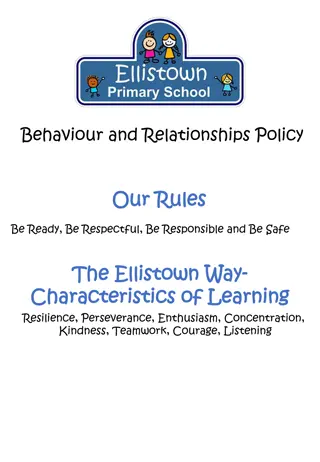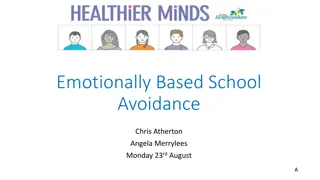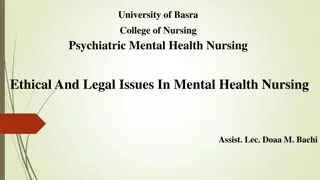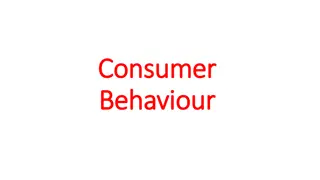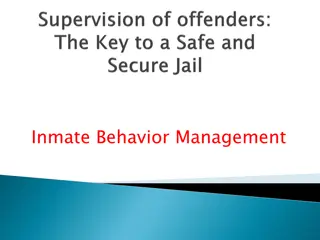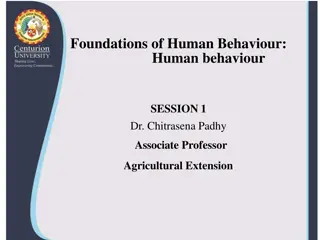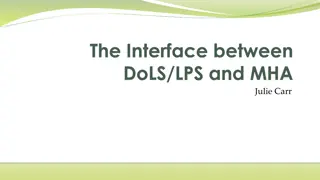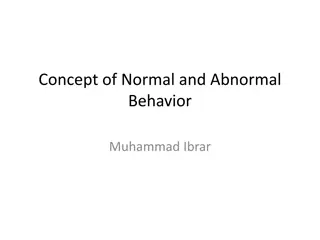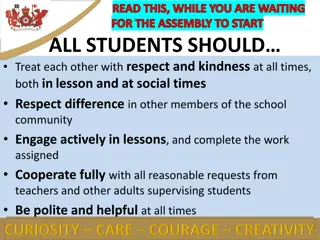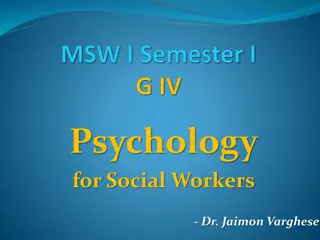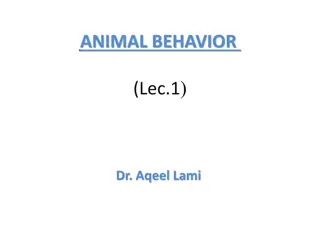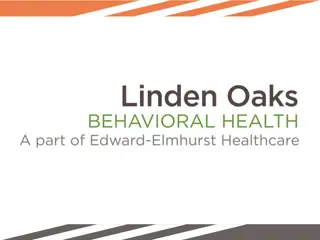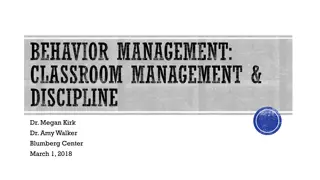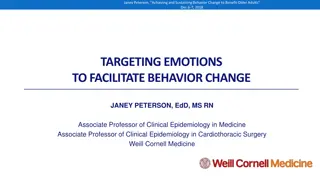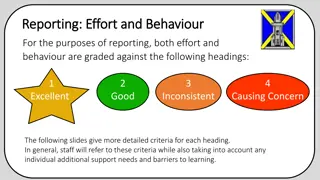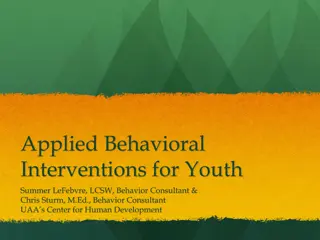School Refusal Behavior
School refusal behavior in children can have various functions, such as avoidance of anxiety-inducing situations, seeking attention, or obtaining tangible rewards. This behavior impacts academic performance, social functioning, and may lead to long-term mental health issues. Thinking functionally about school refusal can help develop targeted interventions to support students in returning to school successfully.
Download Presentation

Please find below an Image/Link to download the presentation.
The content on the website is provided AS IS for your information and personal use only. It may not be sold, licensed, or shared on other websites without obtaining consent from the author.If you encounter any issues during the download, it is possible that the publisher has removed the file from their server.
You are allowed to download the files provided on this website for personal or commercial use, subject to the condition that they are used lawfully. All files are the property of their respective owners.
The content on the website is provided AS IS for your information and personal use only. It may not be sold, licensed, or shared on other websites without obtaining consent from the author.
E N D
Presentation Transcript
FBA AND SCHOOL REFUSAL
SCHOOL REFUSAL BEHAVIOR Child-motivated refusal to attend school or difficulty remaining in classes for an entire day. (Kearney, 2002). Affects between 5-28% of students-no differences between genders Impact of School Refusal Behavior Child, teacher, family stress Limited access to social, academic, mental health and vocational supports Correlation with mood disorders later in life Higher correlation with incarceration, dropping out, poverty Reduced social functioning/academic performance
THINKING FUNCTIONALLY ABOUT SCHOOL REFUSAL BEHAVIOR Typical functions of school refusal behavior (Kearney & Silverman, 1996) Avoid school-based variables that contribute toward feelings of anxiety, depression, etc. Somatic complaints, ask parents to remove from school/home-school Escape aversive school-based social/and or evaluation situations Common situations-talking with peers, cooperating with others, eating in cafeteria with others, oral presentations, tests, performing in front of class, walking in hallway, participating athletically, musically in front of others Students with this function may only refuse school when a triggering event is present
THINKING FUNCTIONALLY ABOUT SCHOOL REFUSAL BEHAVIOR Multi-functional-negative reinforcement (escape)-many student refuse school for both of the above avoidance/escape functions Get attention from others E.g., young children who want to be home with caregivers or want attention from caregivers Separation anxiety may be present at times, but main characteristic is attention- seeking Get tangible reinforcers outside of school Examples include doing things with friends; staying home to sleep, watch TV or computer media; engaging in illegal acts (drugs, smoking, alcohol) This functional class can present with more chronic school refusal behavior compared to other functions Is often associated with extensive family conflict or other complex family issues
AND TO MAKE IT MORE COMPLEX. School refusal can be multi-functional (both escape and obtain) E.g., student may first refuse school to avoid aversive stimuli but likes having access to tangibles or attention when home
RATIONALE OF FUNCTIONAL THINKING ABOUT SCHOOL REFUSAL BEHAVIORS Covers all students who miss school Can generate function-linked strategies that can be feasibly implemented in school by typical practitioners (Kearney & Albano, 2000) School refusal due to anxiety - CBT most commonly used School refusal not due to anxiety- CBT strategies used for anxiety not effective CBT Study (Kearney & Silverman, 1999) Compared function-based and non-function based treatment for eight children/youth Function-based treatment improved Non-function-based treatment resulted in worsening school-refusal rates.
FBA METHODS Interviews will be the primary tool Direct observations when possible Standard FBA interview School Refusal Assessment Scale-Revised (version for family and child) supplement Identifies primary function of school refusal behavior Adequate psychometrics
BEHAVIOR INTERVENTION PLAN Linked to hypothesis Prevention intervention to modify setting event (if present and appropriate) and antecedents Replacement behavior to be taught (functional equivalent and/or desired skills) Reinforcement interventions-increase replacement behavior; decrease school refusal
FBA CELIA, 10 YEARS OF AGE, ANXIETY PRESENT School Refusal Behavior Definition cries (shouts, sobs, reports illnesses) daily at home with parents protesting going to school, eats sparingly, sleeps intermittently through the night, expresses feelings of illness at school including nausea, hot flashes, palpitations, breathlessness, lightheadedness; engages in idiosyncratic speech (speaks in a manner characteristic of very young children) Celia does attend school but is distressed throughout the day. The behaviors above happen every day at home (morning and evening) with the idiosyncratic speech happening in school and home Setting events separation anxiety-In interview, Celia reports that she worries about her parents wellbeing when she is not with them
FBA CELIA, 10 YEARS OF AGE, ANXIETY PRESENT School antecedents being in social situations including PE, eating in cafeteria, parties, riding on school bus, speaking up in class, talking to teachers and administrators; Antecedents for idiosyncratic speech include activities that are non-preferred (e.g. involving social interaction) or boring Consequences/responses from others Home: parents talk, cajole, promise activities and items if Celia goes to school, soothe and calm Teachers provide soothing/calming, other educators provide soothing/calming. Celia rarely gets sent home due to behaviors.
ACTIVITY What would be your hypothesis for Celia s school refusal behavior? Share
POTENTIAL ANSWERS Hypothesis 1: When Celia is: (a) required to be in a setting that separates her from her parents, and (b) required to be in school- based social situations, she will exhibit school refusal behavior. As a result, she gets attention from her parents, specifically her mother, and secondarily from teachers and other adults in school, and obtains soothing of her separation anxiety. Hypothesis 2: When Celia is: (a) required to be in a setting that separates her from her parents, and (b) requested to do activities that are non-preferred (require social interaction or are perceived as boring), she will exhibit idiosyncratic speech. As a result, she gets attention from her parents, specifically her mother, and secondarily from teachers and other adults in school, and obtains soothing of her separation anxiety.
INTERVENTION PLAN Reverse your number of team (e.g. 1 s are 2 s, 2 s are 1 s). Team 1 addresses hypothesis 1 Team 2 addresses hypothesis 2 Come to consensus on a multi-component intervention plan linked to the hypothesis to address Celia s school-refusal behavior. You can focus on an intervention for parents to do at home or school-based interventions or both.
SAMPLE INTERVENTIONS FOR CELIA-HYPOTHESIS 1 Prevention intervention- Setting event modification (for separation anxiety)-Upon arrival each day in school, teacher or other adult prompts Celia to rate her level of anxiety of specific events using a 0-3 scale. (fear ladder)-can also be used by mom the night before or the morning of. Antecedent modification-providing choices at home and in school that would allow her to get attention in an appropriate way. At home, choose among activities that naturally get attention such as cooking with mom (Before school-breakfast, After-school, dinner).
SAMPLE INTERVENTIONS FOR CELIA- HYPOTHESIS 1 Teach interventions-Celia would be taught an appropriate way of getting mom s and the teacher s attention. At home or school, Celia can be taught to say, I m anxious. Mom or teacher can respond with attention and can implement a CBT. CBT-teach Celia a way to self-calm and address her anxiety-e.g., positive thoughts
SAMPLE INTERVENTIONS FOR CELIA- HYPOTHESIS 1 Reinforce appropriate attention-seeking behaviors: Celia would get praise from mom for the choice behaviors Discontinue reinforcing school refusal behaviors (e.g., somatic complaints) at home (parent does not respond with attention when Celia is engaged in a school refusal behavior). Parents redirect to selecting and participating in appropriate choice activity and/or redirect to replacement behavior and CBT.
YANCY-SCHOOL REFUSAL BEHAVIOR NOT RELATED TO ANXIETY 17 years old Missed the last 42 of 61 days of school Says school is boring, prefers to sleep late or hang out with friends during the day or engage in activities at home such as watching TV and eating. Wants to be enrolled in home schooling. Has stated not wanting to return to school due to being behind in schoolwork and facing teachers and peers who will ask millions of questions Family dynamics-Parents divorced; Yancy lives with father; father beginning to consider remarriage, younger brother involved in car accident resulting in less parent attention to Yancy and less supervision given toward attendance; Yancy taken to a psychiatrist who prescribed an antidepressant that has not changed his behavior.
YANCY Function is accessing tangibles/preferred activities Potential Interventions Family involvement = greater success Wrap around supports for the family to address home dynamics Teach Yancy CBT strategy and/or problem-solving peer pressure Working with families to contract with Yancy about attendance; provide tangible reinforcer for attending (e.g., money, extensions of curfew, time with friends, release from household tasks to spend time sleeping or being with friends, other tangibles, etc.) Shaping (similar to desensitization) gradually build up to full day attendance. (e.g., initiate with a few classes or time periods that are most preferred and easiest for student such as lunch)
YANCYS HYPOTHESIS When there is lack of supervision to enforce going to school and tense relationships with dad and school is a non-preferred setting, Yancy will engage in school-refusal behavior (e.g., sleep late, watch TV and eat, spend time with friends instead of going to school). As a result, he gets access to friends and preferred activities.
YANCYS INTERVENTIONS Prevention-establish a routine for AM and PM (morning routine, tasks, and night-time routine-get to bed at specific time, no caffeine 3 hours prior to sleep Teach and Reinforce: Family provided counselor to assist with problem-solving and generating solutions Initial home contract -Yancy does one-task at home for money (e.g., feeding pet dog each day)-no requirement for school Next, prompted (with schedule/contract) to engage in a morning routine including set times for waking, showering, dressing, eating, and preparing for school as if going. Gradually increasing to walking or riding to school but allowing Yancy to say I don t want to attend school if he decides to do so once , , , all the way to school entrance Contingent upon following the schedule, Yancy would be reinforced with time spent with friends in the evening Next, Yancy would attend school-initially one-half day in exchange for doing chores in PM for payment School provided a plan with Yancy for feasible completion of missing work; all professionals were instructed not to call attention to Yancy s missed time in school Contingent upon success, move gradually to full-day attendance Reinforcement-curfew extended to spend time in evening with friends Responses to problem behavior (no longer reinforcing with access to tangibles) If Yancy did not get out of bed in the AM, then he would be required to go to work with father
TAYLOR 16 years, 4 months 11th grade School Refusal Behavior disengagement with school events including walking away from social interactions and complaining about feeling ill (e.g., stating he felt hot or dizzy). Missed 24.6% of school between September and January Antecedents-when required to participate in activities that included social interaction; when presented with a test/quiz Consequences students ignored, teachers removed requirement of interaction and allowed him to work alone; at times, told Taylor to not take the test/quiz
ACTIVITY What is Taylor s hypothesis? What would be Taylor s intervention plan? Share
REMINDER-LINK TO PTR PTR is an FBA/BIP model Consensus on behavior to be addressed and definition IBRST Strategies linked to hypothesis Detailed task analysis Fidelity Coaching Ongoing progress monitoring and data-based decisions




